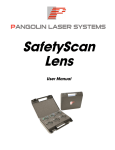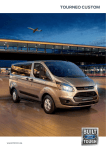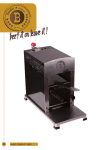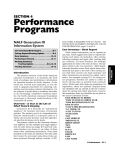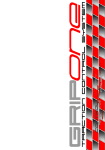Download Safety and utilisation advice
Transcript
1 Safety and utilisation advice Introduction The tyre is the only point of contact between the vehicle and the ground. Users must ensure that they preserve the quality and performance of their tyres. To do so, it is recommended that users adhere to the following safety instructions and user recommendations. These recommendations are valid subject to more restrictive local provisions: legal, regulatory requirements, etc. How do you read a tyre? 190: tyre width in mm 55: tyre series (ratio of height with width of H/S section: 0.55) ZR: structure: radial 17: inside diameter in inches 58: load capacity index W: speed index Name of the range Definitions of other markings: Reinf: "Reinforced”: tyres with an IC greater than the size. Extra Load: New marking with the same meaning as Reinf. DOT: department of transportation Factory code Week and year of manufacture Size code Optional code 2 Choice of tyre • Thechoiceofatyremustbecompliantwithlegislation andwithequipmentrecommendedbythevehicleortyre manufacturerorbyanofficialorganisation(size,loadand speedindices,tyrestructures,etc.).Moreover,itisnecessary totakeaccountoftheconditionsinwhichthetyrewillbeused inorderthatitsperformancemeetstheuser’sexpectations. •Intheeventoftheoriginalvehicleequipmentbeingmodified, itisadvisabletomakesurethatthesolutionofferedis compliantwiththelegislationinforce,thevehicle’stechnical constraints,conditionsofuseandthemanufacturer’s recommendations.(Pleaserefertoregulationsinforceinthe localcountry.)Insomecountries,avehiclethusmodifiedmust receiveadministrativeauthorisation. •Beforebeingfitted,anysecond-handorusedtyremustbe subjectedtocarefulscrutinyinordertoguaranteethesafety oftheuserandcompliancewiththeregulationsinforce (seep.7Vehiclechecksandmaintenance). •Itisrecommendedthattyresofcomparableweararefittedon thesameaxle.Somelegislationsetsamaximumdifferential. •Accordingtolegislationinforceandfortechnicalreasons,itis eithermandatoryorstronglyadvisedtousetwotyresofthe sametreaddesignonthesameaxle. Copyright MICHELIN - All rights reserved 3 Use of tyres • Neverusethetyrebeyondthelimitsofthetechnical specificationsforwhichithasbeenapproved. Certainexcessiveorabnormalgeometricalsettingsforthe vehiclemayhaveaneffectonthetyre’sperformance. • Pooruseorwrongchoiceoftyrecanalsocontributeto prematurewearingofcertainmechanicalparts. Fitting Introduction •Correctfitting,performedinaccordancewithrecommended operatingproceduresandcomplyingwiththesafetyrulesin force,ensuresexcellentprotectionforpeopleandmaterial, andallowsthetyresfullpotentialtobeexploited. •Poorfittingcancausedamagetothetyres,thevehicleorto people(serious,evenfatalinjuries). •Itisthereforeessentialthattheseoperationsarecarriedout bypeoplewhohavebeentrainedandwhohavethe appropriateequipmentavailable. •Iftheoperationiscarriedoutbyanapprentice,thelattermust neverbealone. •Inallcases,itisessentialtorefertothetechnicalinstructions ofthetyremanufacturer,vehiclemanufacturerandwheel manufacturer,aswellastheusermanualforthetyre-fitting machineryorequipment. General precautions •Operatorsmustalwaysweartheirnormalprotectiveclothing. •Operatorsmusthaveaccesstoanoperatingprocedure. •Operatorsmustensurethatthevehicleisstationary,the vehicleengineisswitchedoffandthatthevehicleisproperly stabilised(handbrake,blocks,supports,etc.). 4 Precautions for removal When removing the vehicle wheel •Iftherimshowsevidence ofdamage,thetyresmustbedeflatedpriortoremoval ofthewholefitment. •Ensurethatthetyre’stemperatureallowsittyretoberemoved safely. •Complywiththemanufacturers’recommendationsand instructions. Precautions for fitting •Ensurethatthewheelanditscomponentsareinagood condition. •Checkdimensionalcompliance(tyreandwheel). •Checktyre/wheel,tyre/vehicleandtyre/usagecompliance. •Adheretothepositions,directionoffitting,direction ofrotationandinstructionswhenreferredtoonthetyre sidewalls. •Ifthereisarubbervalve,thismustbereplacedasamatter ofcoursebytubelessfittings. •Iftherearemetallicvalves,checktheairtightnessandcontinue withthereplacementofvalvesorsealsifnecessary. •Afterfittingthetyretothevehicle,atorquewrenchmustbe usedtoachievetheoptimaltorqueasspecifiedbythevehicle manufacturer. Copyright MICHELIN - All rights reserved 5 Precautions for inflating •Tyreinflationisanessentialfactor,notonlyforoptimisation oftyreperformancebutalsointermsofSAFETY. •Itisnecessaryforcorrectvehiclebehaviour(roadholding andbraking)aswellasmaintainingthetyre’sstability. •Onlyuseinflationequipmentintendedforthispurpose andfittedwithapressurelimiter.Innoeventmustaperson oroperatorbeintheimmediateproximityoftheequipmentin ordertobeoutofthepathofanypotentialdischarge intheeventofanincident. Operating pressure •Theinflationpressurethatmustbestrictlyadheredtois thatrecommendedbyvehiclemanufacturerinpassenger. Itcanbefoundatthevehicleusermanualand/or onthevehicleitself. •Under-inflationcansignificantlyaffectthevehicle’sbehaviour.It isalsotrueforexcessiveover-inflation(Vehiclechecksand maintenance,pressurep.7). Balancing •Lackoforfaultybalancingmanifestsitselfintheformof vibrations,withinvariousspeedranges. •Wheelbalancingisthereforeabsolutelyessentialfordriving comfortandcontinuedvehicleandtyreperformance. •Wheelbalancingequipmentmustincludeacentringsystem compatiblewiththewheelhubandbecalibratedinaccordance withthemanufacturers’instructions.Thesetwopointsare determiningfactorsforthequalityoftheoperationcarriedout andareoftenthecauseofdefectivebalancing,whichis manifestedbypersistentvibrations. 6 Storage and maintenance General conditions Storageshouldbe •Inpremisesthatarewell-ventilated,dryandtemperate, protectedfromdirectsunlightandbadweather, •Awayfromanychemicalsubstances,solventsorhydrocarbons likelytointerferewiththenatureoftherubber, •Awayfromanyobjectthatcouldpenetratetherubber(sharp metal,wood,etc.), •Awayfromanysourceofheat,flame,incandescentobject, materialthatcouldcausesparksorelectricaldischargesandany ozonesources(transformers,electricmotors,solderingdevices, etc.). Ifthegaugeallowsthetyrestobestacked,ensurethattheyare notoutofshape. Ifthetyresaretobestoredoveralongperiod,rotatethem (reversetheorderofthetyres). Avoidcrushingtyresunderotherobjects. Moreover,accessoriesmustbestoredintheiroriginalpackaging, onsurfacesthatdonotpresentanydangerofcutting,tearingor perforation. Inallcases,forthehandlingoftyresandaccessories,use instrumentsandequipmentthatisnotharmfultotyres. Operatorsmustalwaysweartheirnormalprotectiveclothing forhandling. Short term storage (up to 4 weeks): Tyrescanbestackedone ontopoftheother,preferably onpallets.Theheight ofthestacksmustnotexceed 1.20meters(4ft).After4weeks, pilesmustbere-madeby reversingtheorderofthetyres. Whentyresaremounted onrims,theymustbestored inflated,inaverticalposition orinasinglerowonshelves. Copyright MICHELIN - All rights reserved 7 Long term storage: Tyresmustbestoredvertically onshelves situatedatleast 10cm(4”)fromtheground. Inordertoavoid distortion,theyshould beslightlyrotated onceamonth. Long-term vehicle immobilisation Ifavehicleisnotusedforalongperiodoftime, tyrepressureshouldbecheckedregularlyandmaintained atlevelsrecommendedbythemanufacturer. Vehicle checks and maintenance General recommendations •Ensurethatthevehicleisstationarybeforeanyinspection. •Tyresmustbeinspectedregularlyinordertodetect anyunusualwearandpotentialdamage. •Wheeltorquemustbecheckedinaccordancewiththevehicle manufacturer’srecommendations. •Anyperforations,cutsorvisibledistortionofthetread, sidewallsorflangeareamustbethesubjectofathorough (internal/external)examinationofthetyrebyatyre professional.Itisthesameforanydamagetotherim. Inallcircumstances,donotputbackintooperationanytyres thatexhibitdamage,suchasdeformedbeadorvisiblebead wire,plyorrubberseparation,visiblecablecords,damagefrom greaseorcorrosiveparticles,marblingorabrasionoftheinterior rubberresultingfromanyrunningatinsufficientpressure. Eachtimethevehicleisinspected,checkthatthevalvecap isingoodcondition.Ifindoubt,replaceit. 8 Checking for wear •Checkingforwearmustalwaysbecarriedoutatseveralpoints onthetyre. •Thischeckcanbecarriedoutusingatyredepthgaugeorby lookingforsignsofwearonthetread(notedonthesidewallby asymbolwhenpresent). •Ifthelegalortechnicallimitforwearhasbeenreached,the tyremustberemovedandreplaced. •Atyreprofessionalmustbeconsultedifthereisabnormalwear oradifferenceinwearbetweentwotyresonthesameaxle. Pressure •Giventhatatyrelosespressurenaturally,itisnecessary toadjustitperiodically;thischeckwillenableanyabnormalloss ofpressuretobedetected. Thischeckmustbecarriedoutonallthevehicle’styres (includingthesparewheelwhenthereisone). •Theuseofavehiclethathastyreswithinsufficientinflation pressureleadstoanabnormalincreaseinoperational temperatureandmaycausedamagetointernalcomponents. Thisdamageisirreversibleandmayleadtothetyrebursting, withsuddendeflation.Theconsequencesofrunningwith insufficientinflationpressurearenotnecessarilyimmediateand mayappearevenafterrectification. •Insufficientpressurealsostronglyincreasestheriskof aquaplaning. •Anoverinflatedtyrecancauserapidandirregularwear, resultinginincreasedsusceptibilitytoimpacts (treaddamage,ruptureofthecarcass,etc.). •Itisrecommendedthattyrepressuresarecheckedwhentyres arecold. •Iftheyarecheckedafterrunning,thetyresarethereforehot. Giventhatpressureincreaseswithtemperature,ahottyremust neverbedeflated. •Ifpressureischeckedwhenhot,thepressureshouldbe readjustedinlinewiththemanufacturer’srecommendations. Iftyrepressureischeckedhot,thepressureshouldbe readjustedinlinewiththemanufacturer’srecommendations. •Inflationwithnitrogenisnotanexemptionfromtheneed tochecktyrepressureregularly. •Inallcircumstances,adheretothepressuresrecommended bythevehicleortyremanufacturers. Copyright MICHELIN - All rights reserved 9 Repair •Allrepairsmustbecarriedoutbyatrainedandqualified professional. •Repairsareprecededasamatterofcoursebyadetailed inspectionofthetyrebytheprofessional.Notalldamagecan berepaired. •Atyrethathasbeenrununderinflatedorflatmayhave sufferedirreversibledamageandonlyanexhaustivecheck oftheinteriorofthetyrewillenableadiagnosisofwhether ornotthetyrecanbeputbackintouse.Removalofthetyre isthereforeessentialinordertoassesswithcertaintyitsactual conditionandthetypeofrepairrequired. •Intheeventofapuncture,injectionthroughthevalve ofsealingproducts(instantpuncturesealant,etc.)canonly beapartialandtemporarysolution.Theseproductscancause complianceproblemswiththetyre,wheel,valve,pressure sensor,etc.Itisessentialtofollowthemanufacturer’s recommendations.Inthiscase,atyreprofessionalmustbe consultedtocheckthetyreand,ifpossible,makean immutablerepair. 10 Product life Tyresaremadefromdifferenttypesofmaterials andrubber-basedcomponents,whosepropertiesareessential totheproperrunningofthetyreitself. Thesepropertiesevolveovertime. Foreachtyre,thisevolutiondependsonmanyfactors, suchasclimate,storageconditions(temperature,humidity, position,etc.),conditionsofuse(load,speed,inflationpressure, roaddamage,etc.)towhichthetyreissubjectedduring itsworkinglife. Theseageingfactorsvarysomuchthatitisimpossibletopredict thelifeofatyrewithanyaccuracy.Thisiswhy,inaddition toregularuserchecks,itisrecommendedtohavethetyres regularlycheckedbyaqualifiedprofessional,whowilldetermine whetherthetyreisfittocontinueinoperation. Thisinspectionmustbecarriedoutatleastonceayear,5years ormorefromthedateofthetyrebeingputintoservice. Theolderthetyre,themoreprobableitisthatitmaybe necessarytoreplaceitduetoageingrelatedtoitsstorageand/or usageorbecauseofotherfactorsestablishedduringchecks. Date of the tyre fabrication Date of the first use 5 years It is recommended to have the tyres yearly checked by a professional We advice the replacement of the tyres 10 years Non-compliance with these recommendations may harm the vehicle’s performance and may cause handling problems and/or malfunction of the tyre that may put the safety of the user and third parties at risk. Michelin may in no way be held responsible for damage that may occur as a result of and/or when being used contrary to its instructions. Copyright MICHELIN - All rights reserved












